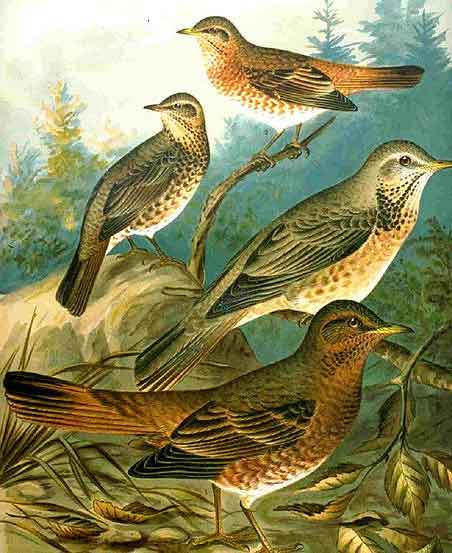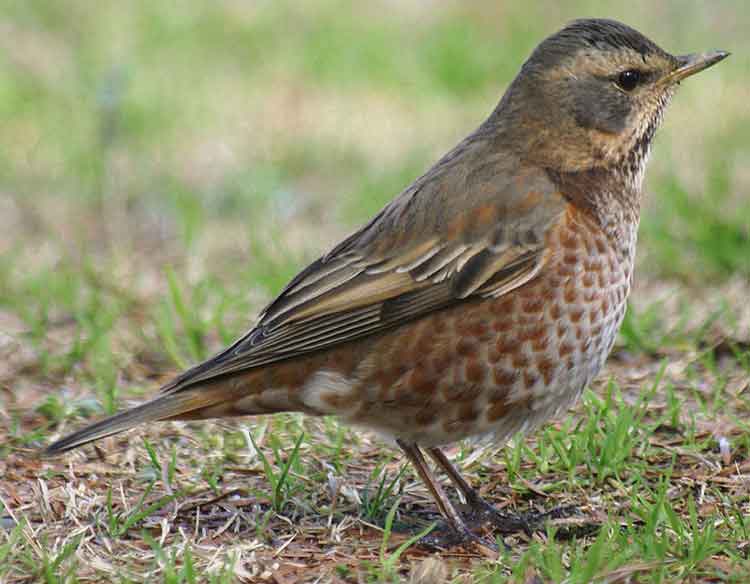
Turdus naumanni (*)
Superregnum: Eukaryota
Regnum: Animalia
Subregnum: Eumetazoa
Cladus: Bilateria
Cladus: Nephrozoa
Superphylum: Deuterostomia
Phylum: Chordata
Subphylum: Vertebrata
Infraphylum: Gnathostomata
Superclassis: Tetrapoda
Cladus: Reptiliomorpha
Cladus: Amniota
Classis: Reptilia
Cladus: Eureptilia
Cladus: Romeriida
Subclassis: Diapsida
Cladus: Sauria
Infraclassis: Archosauromorpha
Cladus: Crurotarsi
Divisio: Archosauria
Subsectio: Ornithodira
Subtaxon: Dinosauromorpha
Cladus: Dinosauria
Ordo: Saurischia
Cladus: Eusaurischia
Cladus: Theropoda
Cladus: Neotheropoda
Cladus: Averostra
Cladus: Tetanurae
Cladus: Avetheropoda
Cladus: Coelurosauria
Cladus: Maniraptoromorpha
Cladus: Maniraptoriformes
Cladus: Maniraptora
Cladus: Pennaraptora
Cladus: Eumaniraptora
Cladus: Avialae
Infraclassis: Aves
Ordo: Passeriformes
Subordo: Passeri
Infraordo: Passerida
Superfamilia: Muscicapoidea
Familia: Turdidae
Genus: Turdus
Species: Turdus naumanni
Name
Turdus naumanni Temminck, 1820
References
Manuel d'ornithologie ed.2 1 p. 170

Turdus naumanni naumanni (*)
Vernacular names
English: Naumann's Thrush
Esperanto: Stepturdo
eesti: Ruskerästas
日本語: ハチジョウツグミ
中文: 斑鶇
The dusky thrush (Turdus eunomus) is a member of the thrush family which breeds eastwards from central Siberia to Kamchatka wintering to Japan, South China and Myanmar. It is closely related to the more southerly breeding Naumann's thrush T. naumanni; the two have often been regarded as conspecific. The scientific name comes from Latin Turdus, "thrush" and Ancient Greek eunomos, "orderly".[2]
This species breeds in open woodland areas, but unlike Naumann's thrush, the dusky thrush is more tolerant of mountainous and tundra-edge habitats. This species is strongly migratory, wintering south to southeast Asia, principally in China and neighbouring countries. It is a rare vagrant to western Europe.[1] In December 2016 a sighting of one in the Derbyshire in the United Kingdom brought hundreds of birdwatchers to see it.[3][4]
From Senchal Wildlife Sanctuary, Darjeeling, India.
It nests in trees, laying 3-5 eggs in an untidy but neatly lined nest. Migrating birds and wintering birds often form small flocks. It is omnivorous, eating a wide range of insects, especially mosquitoes, earthworms and berries.
This is a medium-sized but stocky thrush, reminiscent in structure of a small fieldfare. The underwing is reddish brown, and there is a pale supercilium.
Dusky thrush has a dark brown back and rump; the face, breast, and flank spots rump are black and the belly and undertail are white. Naumann's thrush in comparison has a paler brown back and head; the face, breast, flank spots and rump are reddish, and the belly and undertail are white.
The female is fairly similar to the male, but immatures have a weaker patterning.
The male dusky thrush has a simple fluted or whistling song, similar to the redwing. There are suggestions that the songs of dusky and Naumann's thrush differ.
References
BirdLife International (2016). "Turdus eunomus". IUCN Red List of Threatened Species. 2016: e.T22736111A104201968. doi:10.2305/IUCN.UK.2016-3.RLTS.T22736111A104201968.en. Retrieved 19 November 2021.
Jobling, James A (2010). The Helm Dictionary of Scientific Bird Names. London: Christopher Helm. pp. 152, 393. ISBN 978-1-4081-2501-4.
Amateur's ultra-rare sighting of Siberian dusky thrush brings hundreds of birdwatchers to Derbyshire village December 6, 2016 The Telegraph Retrieved February 19, 2017
Birdwatchers in Beeley to see 'very rare' dusky thrush December 6, 2017 BBC Retrieved February 19, 2017
Retrieved from "http://en.wikipedia.org/"
All text is available under the terms of the GNU Free Documentation License

